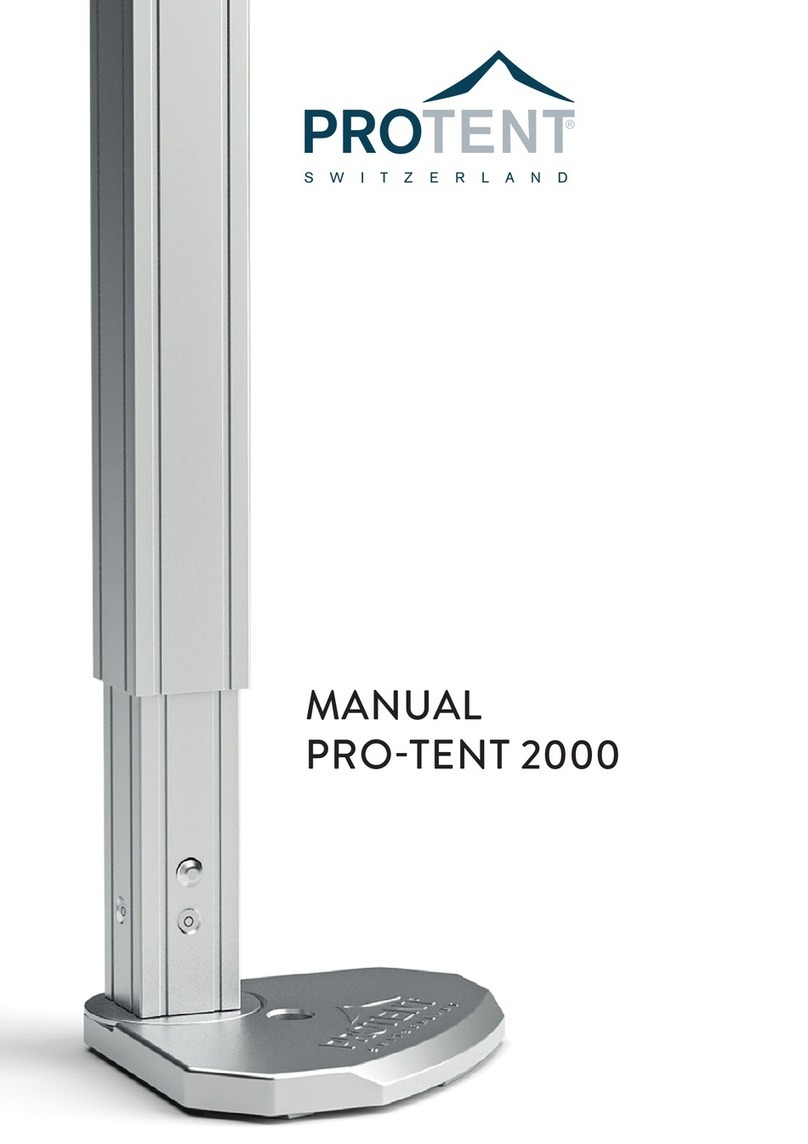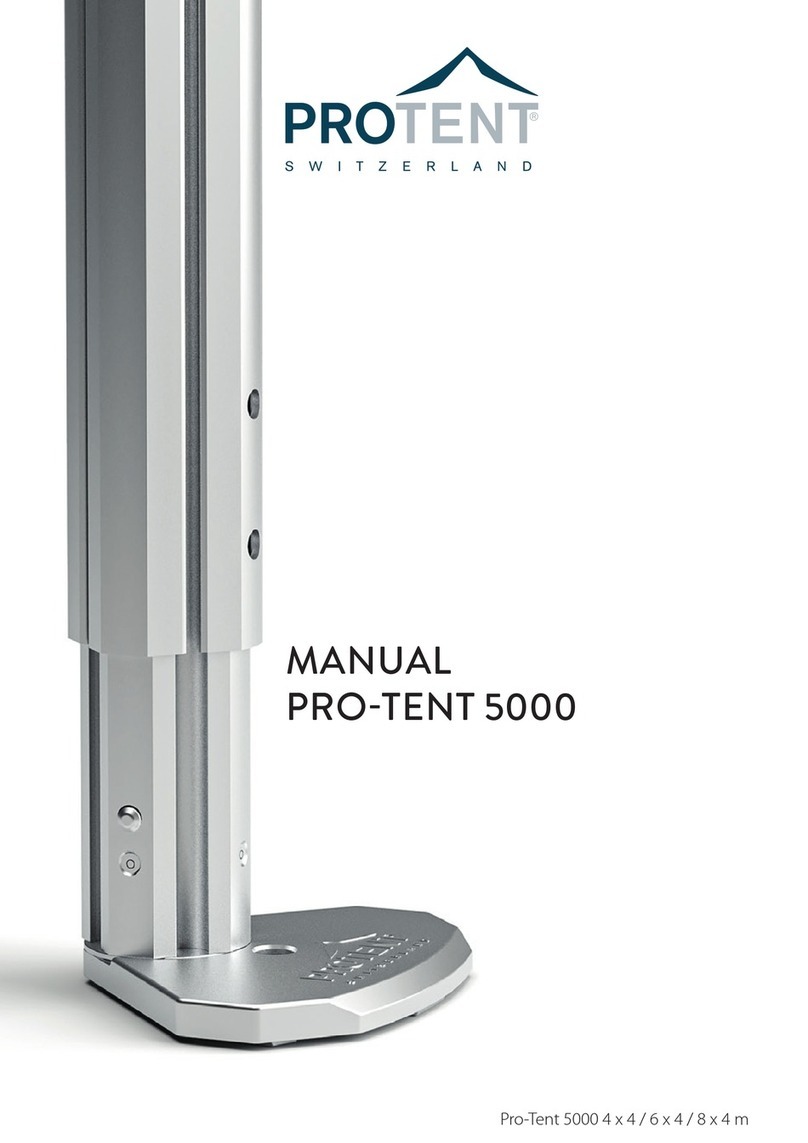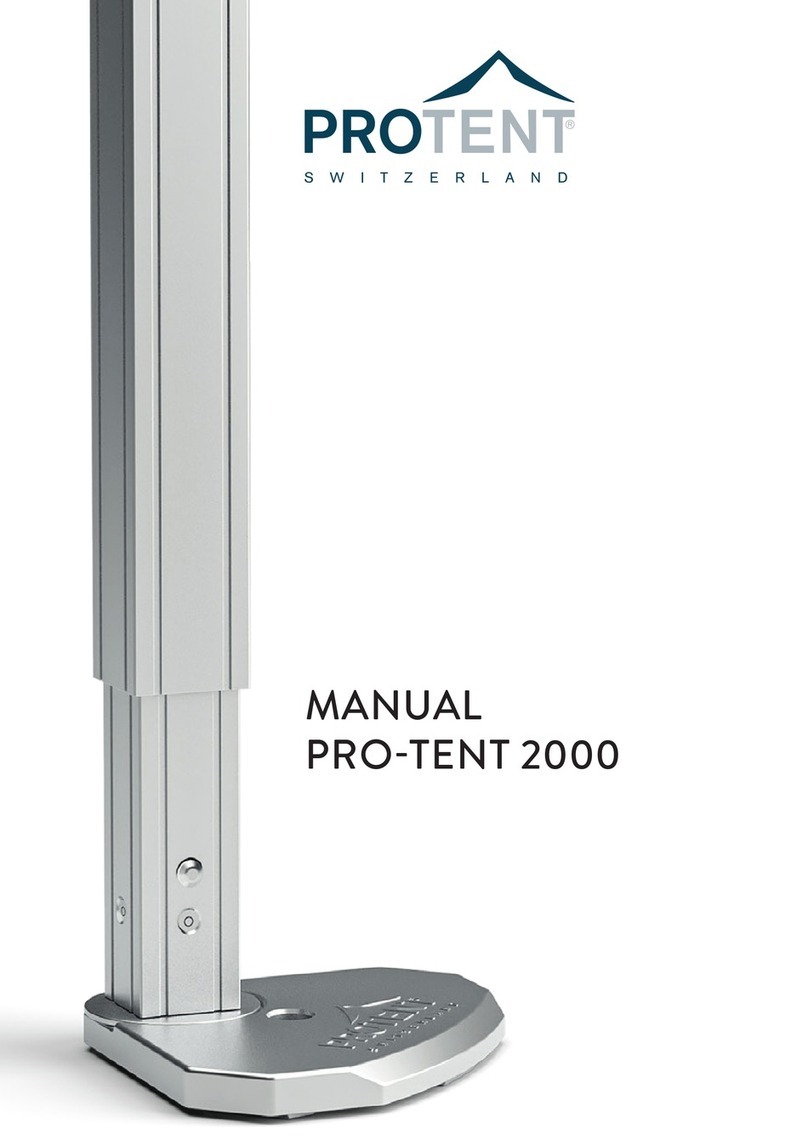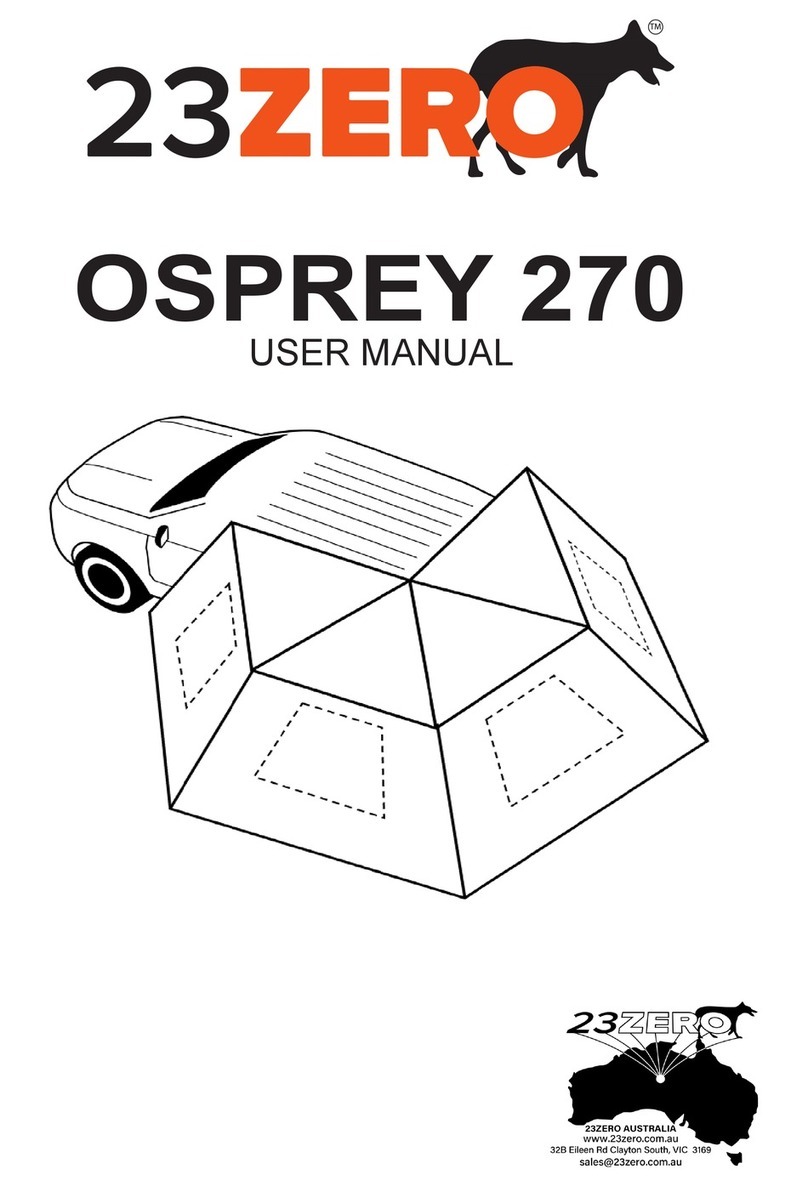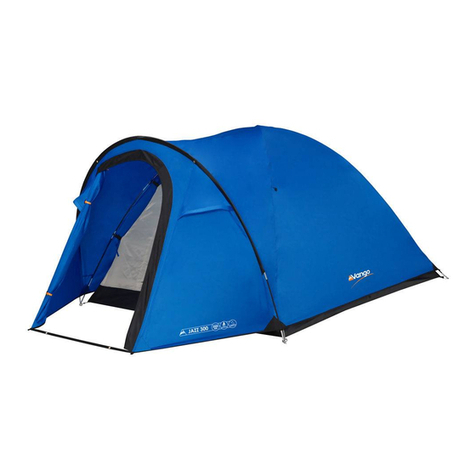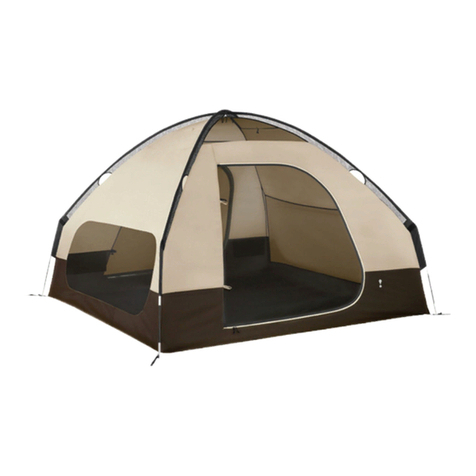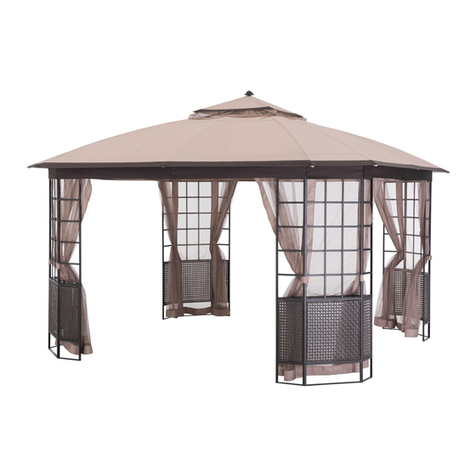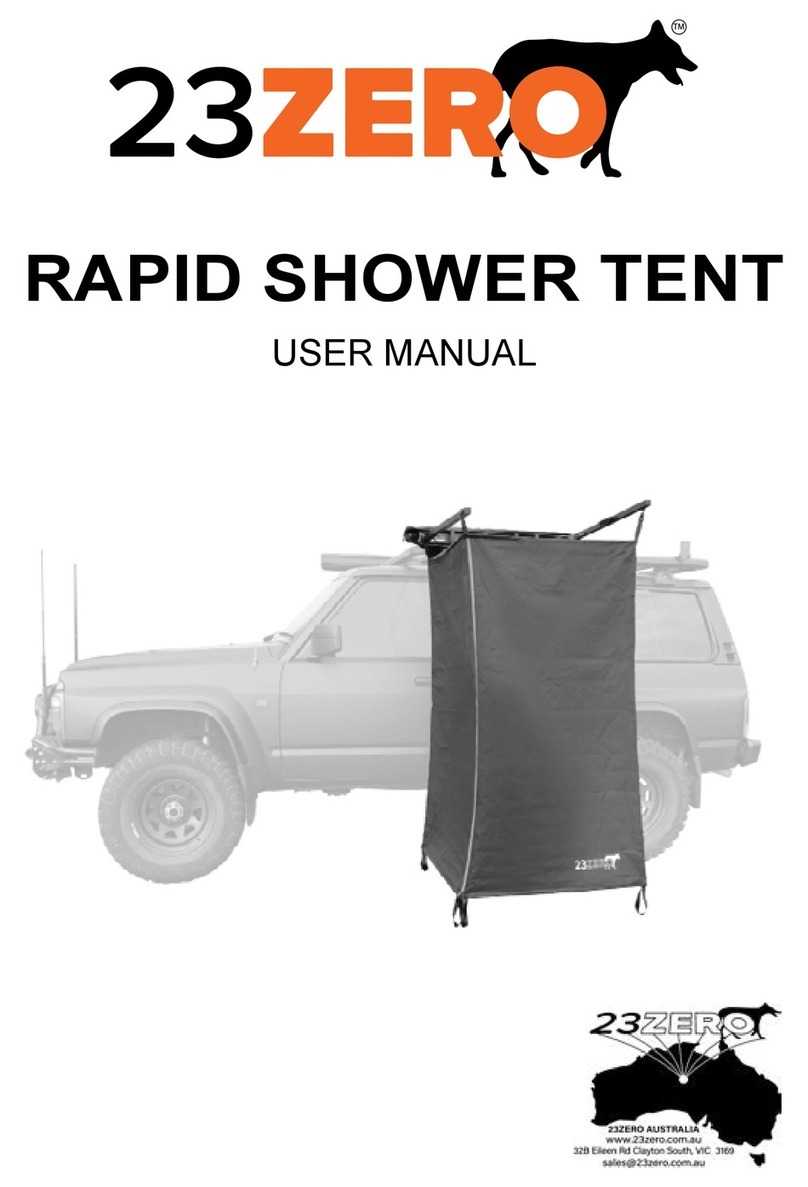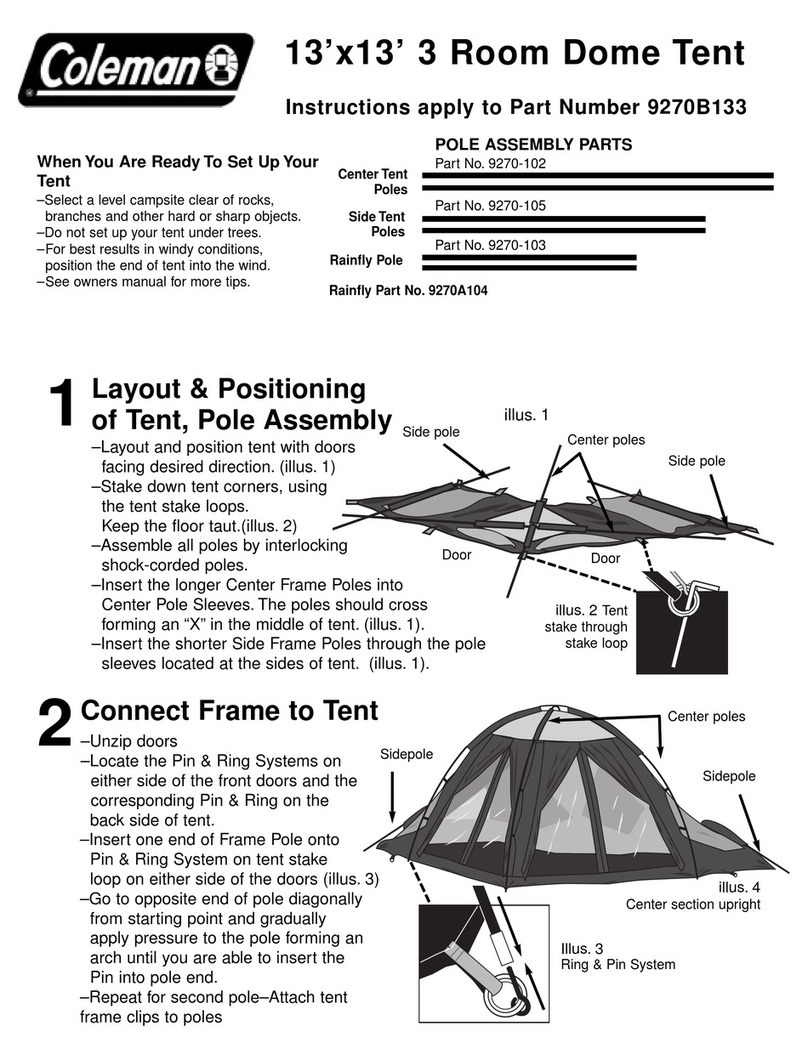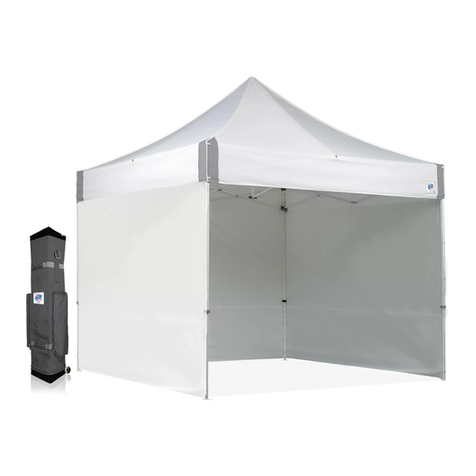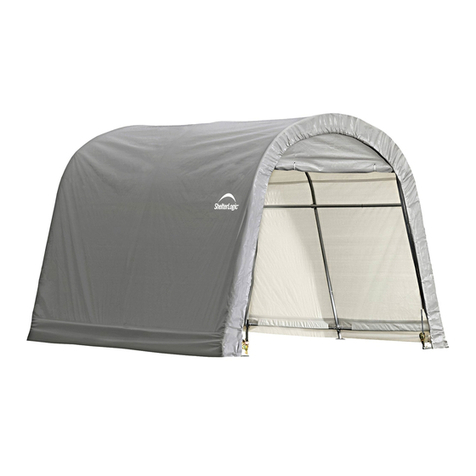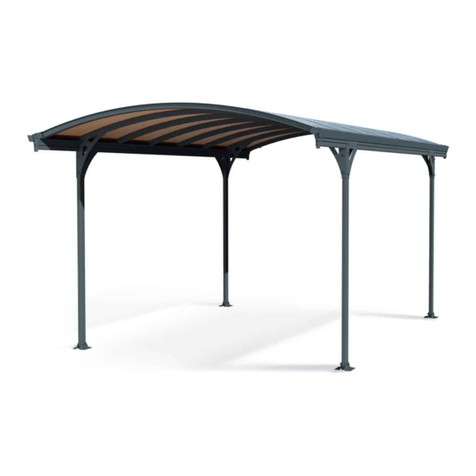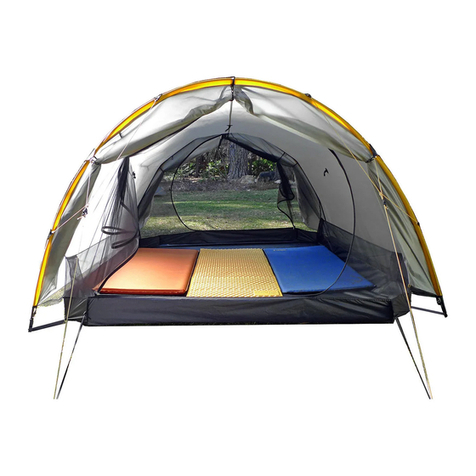PROTENT MODUL 4000 User manual

MANUAL
PRO-TENT MODUL 4000
PRO-TENT 5000
Pro-Tent MODUL 4000 1,5 x 1,5 / 2 x 2 / 3 x 1,5 / 3 x 2 / 4 x 2 /3 x 3 / 4,5 x 3 / 6 x 3 m
Pro-Tent 5000 3 x 3 / 4,5 x 3 / 6 x 3 m

Important points to note
• Pro-Tent tent systems have been designed for temporary
outdoor use to provide protection from sun and rain.
• Pro-Tent tent systems should not be exposed to extreme
weather conditions such as storms, snowfall or hail. In wind
and rain, the Pro-Tent tent systems must be secured with
our weight plates and/or tensioning ropes and tent pegs.
• Bear in mind that the colouring of the synthetic fabric may
fade over time as a result of UV radiation.
• Never fold up the fabric roof when it is damp. It is bestto lay
it loosely over the frame in a dry room.
• Pro-Tent tent systems have been released for delivery by our
quality assurance department and marked "awless in work-
manship and function". If you still have reason to complain
about this product, please contact your local sales oce
immediately.
Product warranty
We grant a 5-year warranty, starting from the day of sale for
the folding construction of the Pro-Tent tent systems. During
this time, our warranty covers the following (upon presenta-
tion of the purchase receipt):
• The free replacement of defective parts due to quality
defects on the part of the manufacturer, including labour
Further claims within warranty processing with the Pro-Tent
tent systems cannot be asserted. Defects that occur as a
result of not complying with these instructions are excluded
from the warranty in all cases.
AREAS OF APPLICATION
2
PRO-TENT MODUL 4000 / 5000

a) 1 aluminium frame
b) 1 carrier bag
c) 2 wheels for mounting on the bag
d) 1 Torx key
e) 1 adapter bar pliers
f ) 1 assembly instructions
g) 1 tensioning set
Remove the wheels from the storage compartment. Screw the wheels into the angle plate on both sides as far
as they will go in the thread.
WHEEL ASSEMBLY
SCOPE OF DELIVERY
a) c)b)
d)
e)
Video transport bag
2 3
PRO-TENT MODUL 4000 / 5000

The Pro-Tent folding tent can be assembled comfortably by
two people. Many steps should be carried out at the same
time. This generally applies to the entire assembly and dis-
mantling process.
Step 1:
Open the buckle at the bottom of the bag. Open the zip of the transport bag,
which is now accessible, as far as it will
go. Use your foot to push the wheels
and the angle plate mounted on them
away from the frame.
Remove the bag from the side of the
frame and store it safely until you need
it again.
Grasp the frame on the outer proles.
Lift the frame slightly. Open the frame
by stepping backwards and spreading
your arms at the same time.
ASSEMBLY
Assembly video
It is best to always
grasp the frame on the
shorter side of the tent -
i.e. on the 3m side of a
6 x 3m tent.
TIP
4
ASSEMBLY

Step 2:
Hold the frame below the middle pivot point by the cross
struts. This is the optimal handling position for opening the
frame. Lift the frame slightly and open it by stepping back
only so far that the gable pole extends about 10 cm.
When positioning
the fabric roof, the
gable pole should only
be extended by
about 10 cm.
TIP
Tensioning
loops
The corners of the fabric roof
are easily recognisable by the
sewn-on tensioning loops. After
the rst assembly, the roof can
remain in place. However, never
store the tent in the transport
bag when it is damp.
TIP
Step 3:
Throw over and x the four corners of the fabric roof to
the outer legs.
4 5
ASSEMBLY

Step 4:
Fasten the velcro straps on the inside of the roof corners
tightly underneath the plastic connector around the leg.
Make sure that the reinforcement ap is placed symmetrically
and without creases around the leg beforehand.
Step 5:
Fixing the roof gable to the protection cover: Push the recess/
slot on the fabric sleeve through the tongue on the prole
cover. Tighten the sleeve rmly using the velcro strap.
6
ASSEMBLY

Step 7:
To engage the roof struts, the plastic gliders must be pushed
out over the top push buttons of the corner legs. This applies
equally to any centre legs if installed.
Tip: Grasp the lower roof strut and push it from above with
your free hand.
Upper push
button
Plastic glider
Step 6:
Grasp the frame again below the middle pivot point at the
cross struts, lift slightly and open the frame by stepping
backwards until the roof begins to stretch.
6 7
ASSEMBLY

Step 8:
Easy tightening of the fabric roof by using the velcro straps.
To do this, pull the roof panel down a little rst.
Push button spring in the upper leg
(locking of the gliders)
Height compensation
for uneven terrain
1.
End position2.
1.
2.
Step 9:
Now pull out all the legs to the end position (2).
Functional explanation of how to engage the legs
Extend the leg: To do this, raise
the leg slightly and only then
pull it out with your foot.
TIP
8
ASSEMBLY

DISMANTLING
1. Loosen all velcro straps on the roof panel.
2. Press the red push button release below the plastic gliders
on each leg. This unlocks the roof frame.
3. Release the push button and retract the legs.
4. Grasp the frame above the middle pivot point on the roof
proles, lift slightly and push together again by stepping
forward but do not close completely to prevent jamming.
5. Push the frame together completely at the upper corners.
6. The frame can now be stowed in the mobile transport bag
together with the roof, which should be smoothed out a
little beforehand. To do this, open the bag completely and
place it sideways over the frame with the fabric roof. Pull
the bag down and slide the angle plate between the
wheels under the plastic gliders of the frame. Then close
the zip and the buckle. Finally the belt must be pulled tight
to ensure safe transportation.
Push button release
8 9
DISMANTLING

SIDE WALLS
3. Slide two adapter strips over the
piping cord on each of the outer two
fabric sections.
Note: In addition to the side wall, four adapter strips (a) are in-
cluded in each carrying bag - 2 per lower leg. The grooves of the
upper leg are continued downwards with the adapter strips. In
this way, the piping cord sewn into the outside of the side wall
is securely guided and held from top to bottom in the leg.
a)
1.
2.
3.
2. Open zips as far as possible. Pull the
two outer, narrow pieces of fabric
into the groove of the upper legs
and velcro them to the inner roof
panel at the top.
Side wall
1. Attach the side wall horizontally
between the two legs to the inner
roof panel.
Video assembly
side wall
10
ACCESSORIES/SIDE WALLS

Removing the side wall
1. Press the adapter strips of the side
wall together at the lower end and
screw them out of the groove of the
leg from the bottom upwards at the
side. Alternatively, the adapter strip
pliers can be used for this purpose.
2. Open the zips about halfway down
the lower leg. Pull the narrow piece
of fabric out of the grooves in the
leg, velcro it to the top of the roof
panel and close the zips.
3. Loosen the velcro on the upper edge
of the side wall across the entire
width. To do this, hold the foot and
head ends of the side wall with one
hand each; it is best to tear velcro
away from the roof panel with a
helper and fold it up immediately
without it touching the ground.
4. Then press the four strips into the
groove of the lower legs and align
them with the lower edge. Then
close the zips again.
4.
10 11
ACCESSORIES/SIDE WALLS

Cross-connectors
1. Pull the top edge with the piping
of the half-height side wall into the
cross-connector, align the connec-
tor at the height of the side wall
between the two legs and lock it in
their prole grooves. To do this, close
the eccentric screws using a Torx key
(approx. 1/2 turn).
2. Open the zips until the two outer
pieces of fabric can be comfortably
pulled into the groove of the upper
legs.
3. Pull in two adapter strips on each of
the two outer fabric pieces and align
them with the lower edge . Then
press the four strips into the groove
of the lower legs. Then close the zips
again.
1.
2.
3.
4. Video assembly
Inside cabins
4. Optionally, a cross connector or tele-
scopic connector can be inserted into
the lower edge of the side wall. This
provides additional transverse stability
and the visually perfect nish.
The inside of the side
wall is easily recognisable
by the sewn-on label with
the serial number.
TIP
12
ACCESSORIES/CROSS-CONNECTORS

Optional legs Pro-Tent MODUL 4000
Optional legs can be inserted at each connection node. These
allow you to subdivide rooms in the module size of 1 m 1.5 m
or also to assemble inside cabins. Attaching additional cross-
connectors or side walls also signicantly increases the stability
of the entire frame.
Attach the optional stand leg to the outside of the frame
(1-4): Push the adapter into the leg with the push button facing
downwards (1) and snap it into the top hole of the leg (2). Insert
the leg with the adapter through the lower 3-piece connector
into the upper 3-piece connector (3). Then pull out the lower leg
to the end position (4).
Attach the optional leg below the gable (5-8): Push the
adapter into the leg with the push button facing downwards
(5) and snap it into the second hole of the leg (6). Remove
the prole cover on the 4-piece connector and place it in the
storage compartment of the transport bag. Insert the leg with
the adapter into the gable (7). Then pull out the lower leg to
the end position (8).
7. 8.
1. 2. 3. 4.
5. 6.
12 13
ACCESSORIES/OPTIONAL LEGS

Optional legs Pro-Tent 5000
Optional legs can be inserted at each connection node. These
allow you to subdivide rooms in the module size of 1.5 m or also
to assemble inside cabins. Attaching additional cross-connectors
or side walls also signicantly increases the stability of the entire
frame. In contrast to the optional Pro-Tent MODUL 4000 support
leg, which only requires one adjustable adapter, the Pro-Tent
5000 has two separate optional support legs for the 3-piece
connector and 4-piece connector.
Attach the optional stand leg to the outside of the frame
(1-3): Insert the leg (1) through the lower 3-piece connector into
the upper 3-piece connector (2). Then pull out the lower leg to
the end position (3).
Attach the optional leg below the gable (4-6): Remove the
prole cover on the 4-piece connector and place it in the storage
compartment of the transport bag. Insert the leg (4) with the
adapter into the gable (5). Then pull out the lower leg to the end
position (6).
5.4. 6.
2.1. 3.
For inserting the
optional legs, always
raise the frame
(end position).
TIP
14
ACCESSORIES/OPTIONAL LEGS

SECURING YOUR TENT IN WIND AND RAIN
Please ensure that the tent is well secured according to
the prevailing weather conditions. Use the tensioning set
supplied for this purpose. Depending on your requirements,
additional 12.5 kg weight plates can be stacked on top of the
existing weight plates and/or 50 l water weights can also be
used to secure the tent on hard surfaces.
To make your tent as secure as possible, you should tension
your folding tent in a way that makes most sense with regard
to physics. The tensioning ropes should lead away from all
four corners of the folding tent at an angle of approx. 45
degrees. Flaps are provided at the corners of the fabric roof
for this purpose.
CAUTION: The tensioning ropes must not be too tightly
fastened. Tension only with moderate force so that the ropes
do not sag. If it is windy, you must check from time to time
whether the tensioning ropes and pegs are still holding rm -
and readjust them if necessary or set the pegs again.
Note: Tensioning is particularly eective and ecient be-
cause it not only keeps your folding tent in place in windy
conditions, but also prevents too much movement from
aecting your folding pavilion, which in the worst case could
damage the construction.
Weight plate hexagonal (12.5 kg)
The modular hexagonal weight plate with a weight of 12.5 kg is
mainly used when a Pro-Tent folding tent needs to be secured
with a lot of weight. Securing the folding tent with sucient
ballast is indispensable, especially if there are no possibilities for
tensioning it.
This weight plate can easily be stacked in up to six layers and
thus applies up to 75 kg of ballast onto a single folding tent leg.
For example, an 8 x 4 m folding tent with six legs can be secured
with up to 450 kg using weight plates. Only the rst weight plate
needs a xing bolt to connect the legs of the folding tent with
the lowest weight plate.
Water weight (50 litres)
The water weight is an additional way of securely tensioning an
aluminium folding tent when being used outdoors. It is used as
an alternative to tensioning the tent with the professional ten-
sioning set. The water weight can be used to increase safety in
strong winds - or when using pegs is not possible or prohibited.
The water weight is made of PVC and is cylindrical. Its diameter
and height are both 40 cm. Its capacity is about 50 litres. Two
twist locks allow easy and quick lling of the water weight with
water as well as uncomplicated emptying. Two handles on the
side make it easy to grab and carry.
The tent is secured
using the tensioning
set included in the
scope of delivery.
Optionally, and to
make handling even
easier, a matching
quick tensioning
set is available see
illustration.
45°
14 15
SECURING IN WIND AND RAIN

PROTENT AG
Zelt- und Messebau-Systeme
Neuhofstrasse 10
8630 Rüti
Schweiz
Tel.: +41 (0) 55 220 28 00
info@pro-tent.ch
www.pro-tent.ch
PROTENT GmbH
Zelt- und Messebau-Systeme
Im Brühl 1
65589 Hadamar-Ndz.
Deutschland
Tel.: +49 (0) 6433 946668-0
info@pro-tent.de
www.pro-tent.de
05/2023
This manual suits for next models
3
Table of contents
Other PROTENT Tent manuals
Popular Tent manuals by other brands
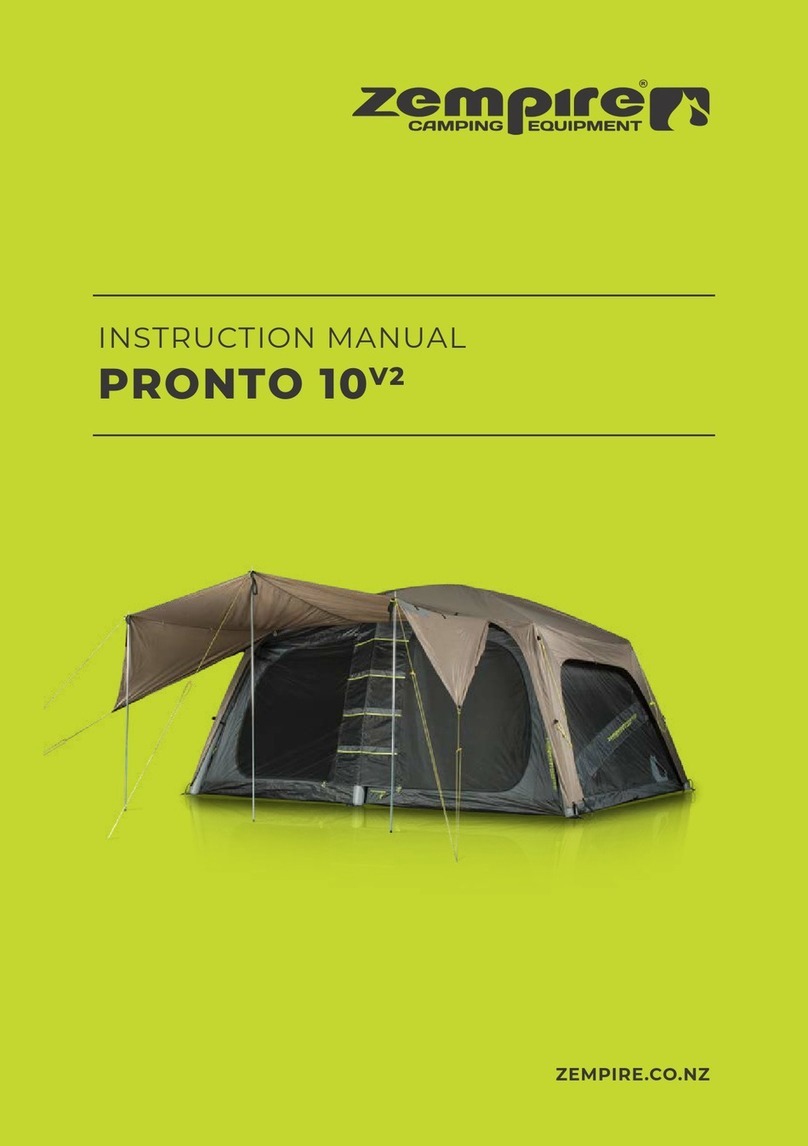
Zempire
Zempire PRONTO 10V2 instruction manual

Outwell
Outwell BLOSSBURG 380 AIR instruction manual
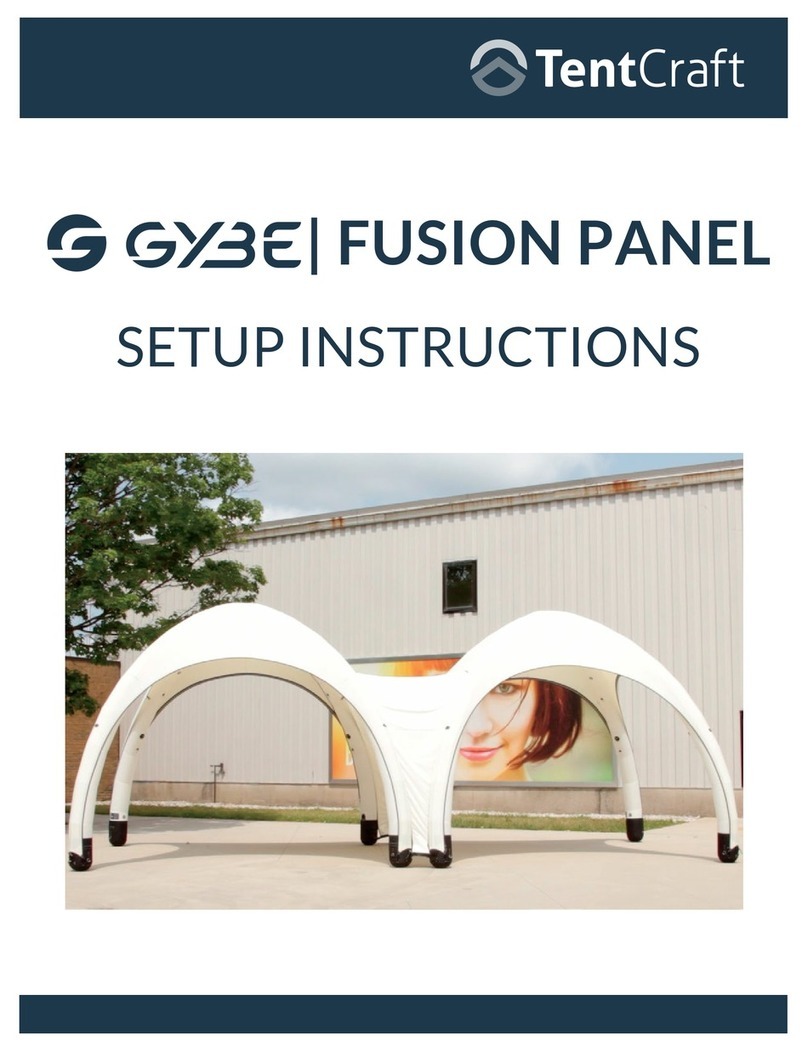
TentCraft
TentCraft GYBE FUSION PANEL Setup instructions

Westfield
Westfield TRAVEL SMART Series quick start guide
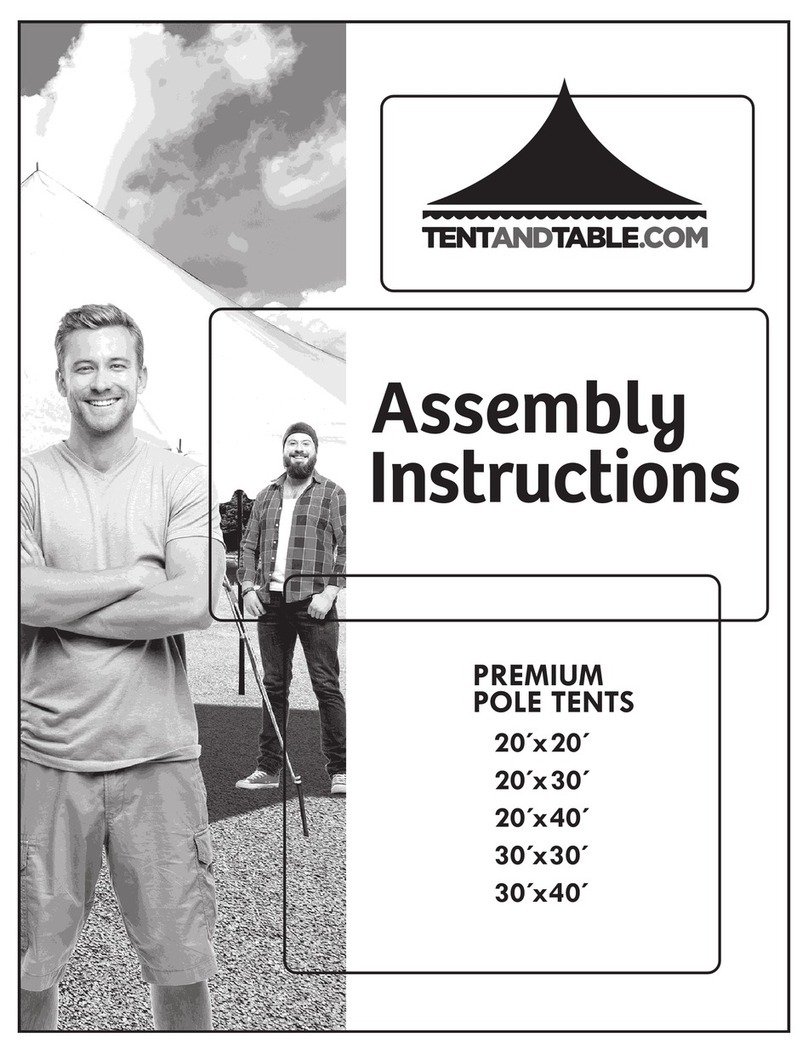
Tentandtable.com
Tentandtable.com Premium Pole Tent 20' x 20' Assembly instructions
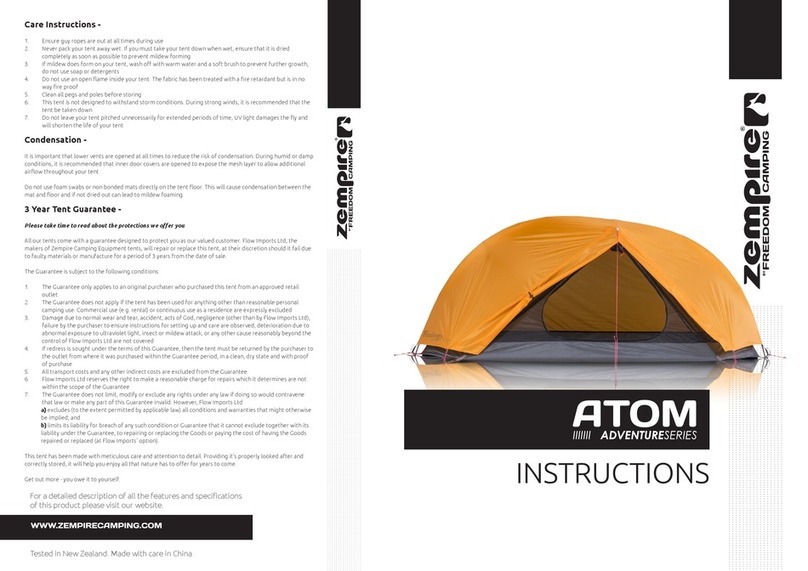
Zempire
Zempire Adventure Series instructions
